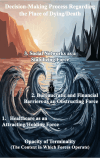Between host country and homeland: a grounded theory study on place of dying and death in migrant cancer patients
- PMID: 40781326
- PMCID: PMC12335150
- DOI: 10.1186/s12904-025-01821-3
Between host country and homeland: a grounded theory study on place of dying and death in migrant cancer patients
Abstract
Background: Migrant cancer patients face unique challenges in end-of-life decision-making. One key yet underexplored aspect is the decision-making process surrounding the place of dying and death. This study explores the factors influencing these decisions involving migrant cancer patients in Italy.
Methods: A constructivist grounded theory approach was employed. Data were collected through semi-structured interviews with 28 participants (patients, family members, cultural mediators, and other key informants, some from a previous grounded theory study). Theoretical sampling guided participant selection for this study, and data analysis followed an iterative coding process, leading to the development of a conceptual model.
Results: The decision-making process was conceptualized as a gradient field in which three forces interact to shape outcomes: (1) Healthcare as an Attracting/Holding Force-quality medical care in Italy encouraged patients to stay, though its influence diminished as curative treatments ended; (2) Bureaucratic and Financial Barriers as an Obstructing Force-challenges related to residency, access to care, and financial constraints often complicated decision-making, particularly for those considering repatriation; and (3) Social Networks as a Stabilizing Force-the strength of familial and community ties in host country and homeland played a decisive role in shaping preferences. A fundamental opacity about terminality was present, with limited communication and awareness regarding prognosis, further expanding the circle of decision-makers.
Conclusions: Palliative care professionals should recognize the importance of transnational networks, consider bureaucratic barriers, and encourage open discussions regarding place of dying and death decision. To navigate these complexities, we propose a question guide for specialists during consultations. This tool aims to enhance culturally sensitive communication, promote shared decision-making, and address the challenges of cross-border end-of-life care. By accommodating transnational ties, palliative care services can better align with the realities of migrant cancer patients, fostering equitable and dignified end-of-life care.
Keywords: Advance care planning; Cancer; Decision-making; End-of-Life; Grounded theory; Migrant patients; Palliative care; Place of death; Transnationalism.
© 2025. The Author(s).
Conflict of interest statement
Declarations. Ethics approval and consent to participate: The Provincial Ethics Committee of Reggio Emilia approved the initial study (protocol No. 2021/0150631), amended in February 2023 (906/2021/OSS/IRCCSRE). Participants provided oral and written informed consent, including authorization for sensitive data processing. Consent for publication: Informed consent was obtained from the participants, explicitly granting permission for the publication of their anonymized data in this paper. Competing interests: The authors declare no competing interests.
Similar articles
-
Gender differences in the context of interventions for improving health literacy in migrants: a qualitative evidence synthesis.Cochrane Database Syst Rev. 2024 Dec 12;12(12):CD013302. doi: 10.1002/14651858.CD013302.pub2. Cochrane Database Syst Rev. 2024. PMID: 39665382
-
Interventions for interpersonal communication about end of life care between health practitioners and affected people.Cochrane Database Syst Rev. 2022 Jul 8;7(7):CD013116. doi: 10.1002/14651858.CD013116.pub2. Cochrane Database Syst Rev. 2022. PMID: 35802350 Free PMC article.
-
The experience of adults who choose watchful waiting or active surveillance as an approach to medical treatment: a qualitative systematic review.JBI Database System Rev Implement Rep. 2016 Feb;14(2):174-255. doi: 10.11124/jbisrir-2016-2270. JBI Database System Rev Implement Rep. 2016. PMID: 27536798
-
Accreditation through the eyes of nurse managers: an infinite staircase or a phenomenon that evaporates like water.J Health Organ Manag. 2025 Jun 30. doi: 10.1108/JHOM-01-2025-0029. Online ahead of print. J Health Organ Manag. 2025. PMID: 40574247
-
Drivers of human papillomavirus vaccine uptake in migrant populations and interventions to improve coverage: a systematic review and meta-analysis.Lancet Public Health. 2025 Aug;10(8):e693-e711. doi: 10.1016/S2468-2667(25)00148-3. Lancet Public Health. 2025. PMID: 40738554
References
-
- European Union E. 2025 [cited 2025 Feb 17]. EU population diversity by citizenship and country of birth. Available from: https://ec.europa.eu/eurostat/statistics-explained/index.php?title=EU_po...).
-
- International Organization for Migration. World Migration Report. 2025 [cited 2025 Feb 13]. Chapter 3 - Migration and Migrants: Regional Dimensions and Developments. Available from: https://worldmigrationreport.iom.int/what-we-do/world-migration-report-2...
-
- Schuster L. The continuing mobility of migrants in italy: shifting between places and statuses. J Ethnic Migration Stud. 2005;31(4):757–74.
-
- Bonifazi C, Paparusso A. Remain or return home: the migration intentions of first-generation migrants in Italy. Popul Space Place. 2019;25(2):e2174.
-
- Istituto Superiore di Sanità. EpiCentro - L’epidemiologia per la sanità pubblica. 2023 [cited 2025 Feb 13]. Migranti e salute. Available from: https://www.epicentro.iss.it/migranti/numeri-italia
MeSH terms
Grants and funding
LinkOut - more resources
Full Text Sources
Medical


